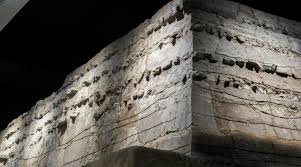By Wu Weizheng, People’s Daily
A newly opened exhibition within Tianjin Metro Line 4’s Dongnanjiao Station is drawing commuters’ attention. The display showcases remains of Tianjin’s ancient eastern city wall – a discovery prompting passersby to pause in curiosity, admiration, or quiet reflection.
With over 600 years of urban history, this wall fragment preserves authentic evidence of Tianjin’s evolution. Its exceptional archaeological value became clear in 2017 when construction uncovered the ruins. Heritage authorities immediately recognized it as one of Tianjin’s most significant 21st-century urban archaeological finds, mandating in situ preservation.
This decision presented a unique challenge: how to balance metro development with historical conservation. The solution emerged through reverence and scientific rigor. Today, eight meters below ground, the ancient wall coexists with modern transit – a tangible “time-space imprint” tracing Tianjin’s transformation from walled settlement to metropolis.
Relocation would have compromised the site’s historical layering and disrupted urban continuity. Instead, construction teams, designers, and heritage experts collaboratively preserved the ruins at their original elevation while advancing the metro project.
Implementation required extraordinary coordination. As a critical transfer hub beneath major thoroughfares, Dongnanjiao Station offered minimal workspace. Through iterative design refinements, computer simulations, and phased construction alternating with archaeological work, the team achieved dual objectives: protecting the heritage site while maintaining vital transportation functions.
Where archaeology and infrastructure development might collide, this project demonstrates how shared purpose and integrated execution can harmonize progress with preservation – turning a subway station into a living museum of urban identity.
The preservation of a non-stone city wall within an operational subway station presented an unprecedented challenge in China. Soft, water-saturated soils threatened structural stability, while confined spaces, complex site conditions, and persistent train vibrations compounded the risks.
Undeterred, a dedicated team pursued a clear conservation vision through ingenuity and perseverance. After meticulous research, they implemented a five-stage engineering process. Using advanced technology, the ancient wall was carefully lifted onto custom spring-mounted supports – simultaneously safeguarding its integrity and isolating it from vibrations. This “mission impossible” became a landmark achievement in harmonizing urban infrastructure with heritage protection, showcasing both scientific ingenuity and unwavering commitment.
Yet conservation alone was insufficient; revitalization was essential. Tianjin masterfully integrated the ancient wall with the modern metro, transforming the preserved relic into a subterranean cultural destination: a museum within a functioning station.
Now woven into the fabric of urban life, the public exhibit invites commuters to engage with history. Visitors encounter the wall’s exposed cross-section and explore the cutting-edge techniques that saved it. This unique space offers dual insights: a window into the city’s layered past and a testament to contemporary engineering excellence.
Here, one senses the planners’ reverence and courage – their prudent balance of public needs and heritage stewardship. Through thoughtful display, history resonates with the present; culture and progress harmonize.
Tianjin’s success underscores a universal principle: by respecting history, embracing cultural values, and adhering to core tenets – prioritize protection, ensure responsible use, minimize intervention – cities worldwide can achieve transformative synergy between development and heritage preservation.
Tianjin Metro Station Unveils Ancient City Wall in Pioneering Heritage Display

Leave a Reply